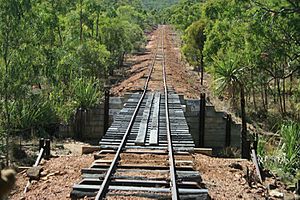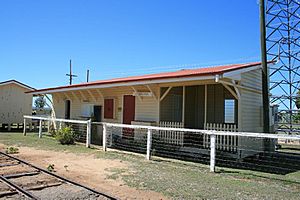Etheridge railway line facts for kids
Quick facts for kids Etheridge railway line |
|
|---|---|

Bridge through the Newcastle Range on the Etheridge railway line, 2008
|
|
| Location | Between Mount Surprise and Forsayth, both in the Shire of Etheridge, Queensland, Australia |
| Official name: Etheridge Railway | |
| Type | state heritage (built) |
| Designated | 16 February 2009 |
| Reference no. | 601637 |
| Significant period | 1907-1910 (fabric) 1907-1995 (historical use) |
| Lua error in Module:Location_map at line 420: attempt to index field 'wikibase' (a nil value). | |
The Etheridge railway line is a special train track in Queensland, Australia. It runs between Mount Surprise and Forsayth. This railway is important because of its history. It was added to the Queensland Heritage Register in 2009.
Contents
Building the Etheridge Railway
The Etheridge Railway line was built a long time ago, between 1907 and 1910. It was created by a company called the Chillagoe Railway and Mining Company. This company also built other railways in the area. The Etheridge line was made to carry ore (rock with valuable minerals) to the company's smelters (factories that melt ore to get metals) in Chillagoe.
The company wanted to build the railway cheaply. So, they used lighter rails and did less earthwork. This made the line different from other railways built at the time.
Who Was John Moffat?
The Chillagoe Company was part of a bigger business group. This group belonged to a man named John Moffat. He was a very important person in North Queensland's history. From 1880 to 1914, many towns and railways were built because of his businesses.
John Moffat came from Scotland in 1862. He started by buying and selling tin. Later, he became interested in silver and copper mining. He built smelters and needed railways to connect them to his mines.
Planning the Railway Network
Moffat wanted a central smelter to process all the ore. To do this, he needed a network of railways. He found investors in Melbourne to help him. In 1897, the Chillagoe Proprietary Company was formed.
This company got permission to build a railway from Mareeba to Chillagoe. Later, a new company, Chillagoe Railway and Mines Limited, took over. They built the main smelter at Chillagoe Creek.
How Was the Railway Built?
Building the Chillagoe line started in 1898. It was finished in 1901. Workers were paid for the amount of work they did. They built strong bridges and culverts (tunnels for water).
Later, the Chillagoe Company wanted more copper ore. They decided to build a branch line, the Etheridge Railway. This line would go south to the Etheridge goldfield and the Einasleigh copper mine. The government agreed to this plan in 1906.
The Etheridge Railway was built to save money. It used timber for bridges and had sharp curves and steep hills. The rails were lighter, and less ballast (stones under the tracks) was used. The line's end point was changed from Georgetown to Forsayth. This was because the mines near Forsayth seemed more promising.
Opening the Stations
The railway reached Mount Surprise in May 1908. Mount Surprise became a key place for moving cattle. In 1916, it had many railway buildings. These included a station, a goods shed, and cattle yards.
The line opened to Einasleigh in February 1909. The Einasleigh copper mine had been discovered much earlier. But it was too expensive to transport ore. The railway changed this, and Einasleigh became a busy town.
By July 1909, the train reached Wirra Wirra. By January 1910, ore trains were running to Chillagoe from near Forsayth. The station at Forsayth was officially named in December 1910. Regular trains ran three times a week.
Government Takes Over
The government took over running the Etheridge railway in 1911. Cattle transport became very important as mining slowed down. Many small sidings (short tracks for trains to wait) were along the line.
In 1914, the Chillagoe Company faced problems. They closed their smelters. The government then bought the railway and other assets in 1919. The Chillagoe smelters reopened in 1920, run by the government.
John Moffat retired in 1912 and passed away in 1918. He helped North Queensland grow a lot. His railways helped farmers too, by making it cheaper to move supplies and cattle. Even though gold mining had a brief comeback, cattle farming kept the towns along the Etheridge line alive.
Floods and Changes
In 1927, floods destroyed six bridges on the line. The government wanted to close part of the line. But people protested, and it reopened in 1928. It was fixed for lighter railmotors.
Later, from 1949 to 1951, the line from Almaden to Mount Surprise was improved. This allowed heavier steam trains to carry more cattle. However, a new "Beef Road" for trucks reduced the railway's use for cattle in the 1960s.
The line closed again after floods in 1974 but reopened quickly. In the mid-1990s, people protested to save the train service. This led to the creation of the Savannahlander tourist train. Since 1998, the Savannahlander travels from Cairns to Forsayth, using the Etheridge line. It's a great way to see the area!
What Does the Railway Look Like?
The Etheridge Railway line is about 230 kilometers long. The part included in the heritage listing is from Mount Surprise to Forsayth, which is about 121 kilometers. The railway was built simply. It often has no metal ballast under the sleepers (the wooden or steel beams holding the rails).
The line mostly follows the natural shape of the land. It has small cuttings (cuts into hills) and embankments (raised sections). But there are bigger earthworks in the Newcastle Range section.
Important parts of the railway today include the buildings, tracks, sidings, and old equipment. These show how the railway worked for mining and farming.
Mount Surprise Railway Station
At Mount Surprise, you can see many interesting things. There's an old signal frame and a turning fork (a track for turning trains around). There are also two old railway houses and a metal sandbox. A large water tank on a timber stand is also there. This tank used to provide water for the steam engines.
The station building is made of timber with a corrugated iron roof. It has a waiting area and an office. The goods shed is also timber and corrugated iron. It has a loading platform for moving goods.
Einasleigh Railway Station
Einasleigh station also has old signal frames and sandboxes. There are sidings and loading banks. The station building has a skillion roof (a single sloping roof) and is made of timber. It has an office and toilets.
A special feature is the fork line and cattle yards north of the station. The nearby station master's house is also very old and important.
Forsayth Railway Station
At Forsayth, you can find a signal frame and trolley sheds. There's a siding and a turning fork. The station building is made of timber. It has been changed over time but still shows its original style.
The goods shed is also made of corrugated iron. It has a loading dock. There are two trolley sheds, which are small buildings for railway trolleys. The cattle yards are made of steel and timber.
A unique feature at Forsayth is the framed tent quarters. These are old buildings that look like tents. They show what railway workers' homes were like long ago.
Newcastle Range and Delaney Gorge
This part of the railway has more earthworks. The track runs along the Delaney Gorge and near the Delaney River. You can see stone bridges, culverts, and stone cuttings here. These stone structures are rare on the Etheridge line.
At Wirra Wirra, there's a siding. You can still see parts of the old fork and concrete slabs. These are reminders of the railway's past.
Why Is This Railway Important?
The Etheridge Railway is listed as a heritage site for several reasons.
A Look into Queensland's Past
This railway shows how Queensland developed. It was a big part of the mining boom in North Queensland. It helped transport ore and supplies. The railway also helped local farmers by making it easier to move cattle.
The way the government handled this private railway was also new. It was the first step towards how mineral railways are managed today.
Rare and Special Features
The tent quarters at Forsayth are very rare. They give us a glimpse into the lives of railway workers from the early 1900s. The large iron water tank at Mount Surprise is also a rare example of its kind.
Showing How Railways Worked
The buildings, tracks, and equipment at Mount Surprise, Einasleigh, and Forsayth show how a railway line worked for mining and farming. The way the line was built, with its steep hills and sharp turns, shows how they tried to build it as cheaply as possible.
The Mount Surprise station has many original buildings. These include the station building, goods shed, and water tank. They help us understand how a rural railway station operated.
Connected to Important People
The Etheridge Railway was key to John Moffat's business. He helped build North Queensland's economy through mining and railways. His work greatly influenced the region's growth.
Images for kids





